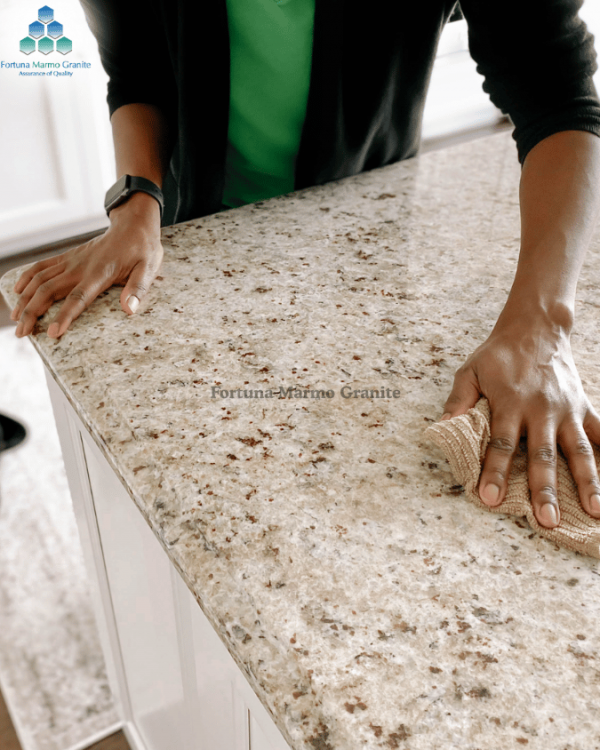How to Clean Granite Countertops: Tips for a Long-Lasting Shine
How to Clean Granite Countertops Granite countertops have long been celebrated as a premium choice for kitchens and bathrooms because of their exceptional combination of natural beauty, strength, and longevity. Consequently, With their rich, varied patterns and colors, they add a sophisticated, elegant touch to any interior, making them highly favored by homeowners, designers, and builders alike. Beyond their aesthetic appeal, granite is renowned for its durability—it can withstand heat, scratches, and everyday wear far better than many other countertop materials, making it perfect for busy kitchens and frequently used bathrooms.
Despite its toughness, granite remains a natural stone that benefits from regular care to preserve its flawless appearance. Periodic resealing is particularly important, as it reinforces the stone's protective barrier and prevents moisture infiltration. In addition, proper maintenance helps maintain the countertop's dazzling finish and extends its lifespan, ensuring it continues to enhance both the beauty and functionality of your kitchen or bathroom for years.
Moreover, This guide offers expert tips and practical techniques for everyday cleaning, stain removal, and preventative care. In addition, By following these recommendations, you can keep your granite countertops spotless, vibrant, and gleaming like new.


Daily Cleaning: The Foundation of a Long-Lasting Shine
- Wipe Up Spills Immediately
The golden rule for granite is to wipe up spills as soon as they happen. Whether it's coffee, wine, olive oil, or fruit juice, immediate action prevents liquids from seeping into the pores and causing stains. Use a soft, absorbent cloth or paper towel.
- Gentle Daily Cleaning Solution
For daily wiping, a simple solution is often the best.
- Warm Water and Mild Dish Soap: Mix a few drops of pH-neutral dish soap (like Dawn or Palmolive) with warm water in a spray bottle. This creates a gentle yet effective degreaser.
- Granite Cleaner: Alternatively, you can use a specially formulated pH-neutral granite cleaner. These are designed to clean without damaging the sealer or leaving streaks.
- The Cleaning Process
- Spray a light mist of your chosen cleaning solution onto the countertop.
- Wipe the surface with a soft microfiber cloth. Microfiber is excellent for picking up dirt and grime without scratching.
- Rinse the cloth frequently to ensure you're not just spreading dirt around.
- For best results, follow up with a dry, clean microfiber cloth to buff the surface and prevent water spots, leaving a streak-free shine.
- Avoid Harsh Cleaners for Daily Use
Never use acidic cleaners (vinegar, lemon juice), ammonia-based cleaners (Windex), abrasive cleaners, or scouring powders for daily cleaning. These can strip the sealant, etch the surface, and dull the granite's natural shine.
Deep Cleaning and Stain Removal: Tackling Tougher Challenges
Identifying the Stain Type
Before tackling a stain, try to identify its source. Different types of stains require different approaches. Common stains include:
- Oil-based stains (grease, cooking oil, cosmetics): These darken the granite and usually require a degreasing agent.
- Water-based stains (coffee, tea, wine, ink, food coloring): These often leave a colored residue.
- Organic stains (food, mildew, algae): Often appear as pink, brown, or black spots.
- Metallic stains (rust from iron pots): Leave a reddish-brown mark.
Poultice for Stubborn Stains
A poultice is a paste-like mixture that absorbs stains from porous materials like granite. It's an effective method for drawing out deep-set stains.
How to Make a Poultice:
- Absorbent Material: Choose an absorbent material like white flour, baking soda, powdered chalk, or paper towels shredded into a fine pulp.
Chemical Agent (based on stain type):
- Oil-based stains: Mix the absorbent material with hydrogen peroxide (3-6%) or acetone (nail polish remover without added oils).
- Water-based and organic stains: Mix the absorbent material with hydrogen peroxide or rubbing alcohol.
- Metallic stains: Use a commercial rust remover specifically designed for natural stone, or consult a professional.
Poultice Application:
Prepare the area: Start by cleaning the stained area thoroughly with mild soap and water, then allow it to dry completely.
Mix the poultice: Next, create a thick paste—similar in consistency to peanut butter—using your chosen absorbent material and chemical agent.
Drying time: Allow the poultice to sit and dry fully, usually for 24–48 hours. For particularly stubborn stains, it may require even longer. As it dries, the absorbent material draws the stain out of the granite.
Remove and clean: Once the poultice is dry, gently scrape off the hardened paste using a plastic scraper. Afterwards, rinse the area with distilled water and wipe it dry with a clean microfiber cloth.
Repeat if necessary: Finally, for persistent stains, repeat the poultice application until the granite is fully clean.
Conclusion
Indian Granite Supplier keeping your granite countertops clean and well-maintained is essential to preserving their natural beauty, durability, and timeless elegance. Granite is a remarkable natural stone that, when properly cared for, can last for decades while enhancing the aesthetic and functional value of your kitchen or workspace. The key to a long-lasting shine lies in adopting a regular cleaning routine that uses gentle, non-abrasive, and pH-neutral cleaning agents to avoid damaging the stone's surface. Additionally, promptly addressing spills—especially acidic substances like lemon juice, vinegar, or wine—prevents staining and etching, which can dull the granite's finish over time.
At Fortuna Marmo Granite, we not only supply premium quality Indian granite with a variety of finishes and dimensions but also take pride in offering expert guidance on how to properly care for and maintain your granite surfaces. Our extensive experience and deep knowledge of natural stone products enable us to assist clients worldwide in maximizing the lifespan and beauty of their granite installations. Whether you are a homeowner looking to protect your investment or a professional seeking reliable and durable stone solutions, Fortuna Marmo Granite stands as your trusted partner, committed to delivering excellence both in product quality and customer service.

